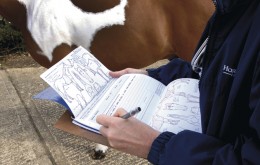The pre-purchase examination provides assessment of the horse at the time of examination to help inform the potential purchasers decision whether or not to continue with their purchase. The assessment reflects the objective facts ascertained by the veterinary surgeon on the day of the examination.
5-stage vetting
This is considered the gold standard examination.
Stage 1 – Preliminary examination: This is a thorough external examination of the horse at rest using visual observation, palpation and manipulation to detect clinically apparent signs of injury, disease or physical abnormality. This stage includes examination of incisor teeth and eyes, and listening to the horses heart and lungs at rest.
Stage 2 – Walk & trot in hand: This is performed to detect any gait & action abnormalities. Flexion tests on all limbs are performed.
Stage 3 – Exercise phase: Usually the horse is ridden and given sufficient exercise to: 1. Allow assessment of the horse under increased breathing and heart rate 2. Allow assessment of the horses gaits 3. For the purpose of stage 5
Stage 4 – Period of rest and re-examination: During this time respiratory and cardiovascular systems are monitored as they return to resting levels.
Stage 5 – Second trot up: The horse is trotted in hand to look for any signs of strains or injury made evident by exercise.

It is strongly recommended that a blood sample is taken for storage for possible future analysis to detect substances present in the horses system at the time of examination which may have masked any factors affecting the horse suitability to the purchaser (additional costs apply).
We also offer 2-stage vetting examinations which only include the first two stages as shown above. It should be noted that there are obviously limitations with this, and therefore higher risks that the potential purchaser should be aware of. It is advised to check with the insurance company that you intend to use before deciding on the type of vetting as some may have stipulations.

